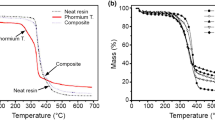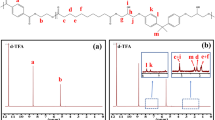Abstract
The development of the reactions and early-age properties of a system consisting of calcium sulfate hemihydrate and acrylamide monomer was studied. The hydration of the hemi-hydrate and the polymerization of the acrylamide were determined at various time intervals, and the expansion and rise in temperature were continuously recorded. Setting times and flow were determined using standard test methods. It was shown that acrylamide and hemi-hydrate could react simultaneously to form gypsum and polyacrylamide composite in which the reactions to form both components advanced almost until completion, for mixes containing up to 10% acrylamide. Increase in the content of acrylamide improved the flow properties of the mix, but delayed the setting. At contents of 2% acrylamide, the hemi-hydrate reaction occurred prior to the polymerization process. Above 6% acrylamide, the polymerization reaction preceded the hemi-hydrate reaction. This sequence of reactions can account for the observations that above 6% acrylamide two peaks in the heat liberation curves could be detected as well as that expansion was smaller at the higher acrylamide content, due probably to separation between gypsum crystals forming when the polymer is already present.
Résumé
On a étudié le développement des réactions et des propriétés au jeune âge d'un système composé de monomères d'acrylamide et de semi-hydrates de sulfate de calcium. L'hydratation du semihydrate et la polymérisation de l'acrylamide ont été déterminées à différents intervalles de temps, tandis que l'expansion et les élévations de température étaient enregistrées de façon continue. Le temps de prise et la fluidité ont été mesurés à l'aide d'essais normalisés. Les résultats obtenus montrent que l'acrylamide et le semi-hydrate peuvent réagir simultanément et forment un système composé de gypse et de polyacrylamides. Les réactions nécessaires à la formation de ces deux constituants sont presque complètes pour des mélanges contenant jusqu'à 10% d'acrylamide. Une augmentation de la quantité d'acrylamide a amélioré la fluidité des mélanges, mais a retardé le temps de prise. Pour des contenus en acrylamide de 2%, le semi-hydrate a réagi avant que la polymérisation se soit produite. Pour des contenus en acrylamide supérieurs à 6%, la réaction de polymérisation a précédé celle du semi-hydrate. Cette succession de réactions expliquerait la présence des deux pics observés dans les courbes de chaleur libérée, ainsi que le fait que l'expansion était plus faible pour le plus haut contenu en acrylamide. Cela est probablement dû à la séparation entre les cristaux de gypse qui se forment lorsqu'un polymère est déjà présent.
Similar content being viewed by others
References
Zakaria, M.R., Johnston, W.M., Reisbisck, M.H., and Campagni, W.V., ‘The effects of a liquid dispersing agent and a microcrystalline additive on the physical properties of type IV gypsum’,J. Prosthetic Dentistry,60 (5) (1988) 630–637.
Sherr, E.A. and Roshel, J., ‘Plaster compositions’, I&Ec Product Research and Development,8(2) (1969) 193–196.
Sand, M.E.A., Combe, E.C. and Grant, A.A., ‘Hardening model and die materials by epoxy resins’,J. Dentistry,8 (2) (1969) 2274–2276.
Whittaker, J. and Jacobson, P.H., ‘Improvement in the method for the impregnation of gypsum casts’,J. Materials Science,13 (1978) 1145–1146.
Smith, B.R. and Alexander, A.E., ‘The effect of additives on the process of crystallization’,J. Colloid and Interface Science,34 (1) (1970) 81.
Kuntze, R.A., ‘Retardation of crystallization of calcium sulfate dihydrate’,Nature,23 (211) (1966) 406.
Stav, E., Kohn, D.H. and Bentur, A., ‘Polymerization of acrylamide in the presence of calcium sulfate dihydrate and calcium sulfate hemihydrate’,J. Applied Polymer Science,45 (12) (1992) 2079–2089.
Stav, E., Bentur, A. and Kohn, D.H., ‘Polymerization of acrylamide in the presence of calcium sulfate hemi-hydrate: compressive strength and microstructure of the composite’,Advances in Cement Research,4(14) (1991/1992) 57–60.
Thomas, W.M., ‘Acrylamide Polymers’, pp 176–177 in ‘Encyclopedia of Polymer Science and Technology’, Vol. 1, Wiley-Interscience, New York, (1964).
Stav, E. and Bentur, A., ‘Characterization of hydration process of calcium sulfate hemi-hydrate by simultaneous evaluation of chemical and physical parameters’, accepted for publication,Advances in Cement Research.
Author information
Authors and Affiliations
Additional information
Editorial note Prof. Amon Bentur and Dr. E. Stav are working at the Technion, Isarel Institute of Technology, Haifa, which is a RILEM Titular Member. Prof. Amon Bentur is the RILEM Delegate in Israel. He has been appointed chairman of the Technical Committee ETC on Engineering of the interfacial Transition zone in Cemetitious composites.
Rights and permissions
About this article
Cite this article
Stav, E., Bentur, A. Reactions and early-age properties inin-situ polymerized gypsum-acryl amide composites. Mat. Struct. 29, 366–371 (1996). https://doi.org/10.1007/BF02486345
Issue Date:
DOI: https://doi.org/10.1007/BF02486345




